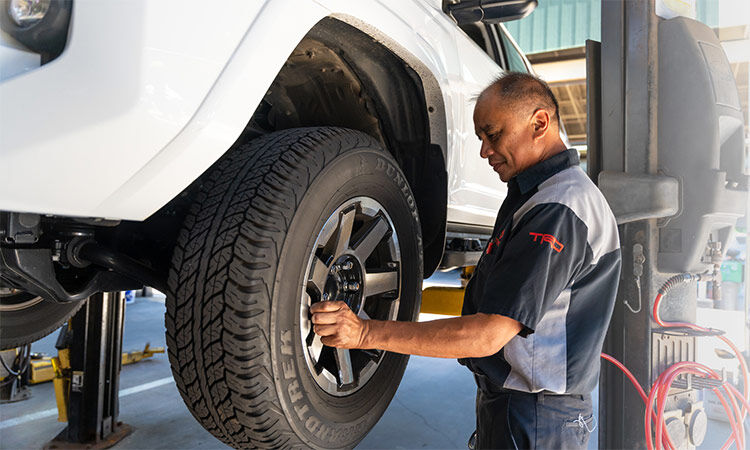Drive with Self-confidence: GMC Tires Service at Morris Tires
Drive with Self-confidence: GMC Tires Service at Morris Tires
Blog Article
Tire Service: The Effect of Climate Condition
When it comes to making sure ideal performance and safety on the roadway, understanding the influence of weather conditions on tire solution is essential. GMC Tire Service. In this discussion, we will certainly check out the complex partnership between weather condition conditions and tire service, losing light on the significance of weather-specific tire maintenance methods and factors to consider.
Warm and Tire Efficiency
When subjected to high temperatures, tires experience changes in efficiency that can dramatically impact vehicle safety and security and handling. The heat produced from prolonged driving or warm weather condition conditions causes the tire rubber to soften, leading to reduced step life and boosted wear.

Winter Results
Cold weather condition problems can have a significant influence on tire efficiency and safety and security. As temperatures decrease, tire rubber can harden, causing reduced traction on icy or snow-covered roads. In cold weather, tires might additionally shed air pressure much more rapidly, which can impact handling and fuel efficiency. Additionally, cold temperature levels can create tire sidewalls to stiffen, raising the threat of damage from splits or various other road risks.
To minimize the effects of winter on tires, it is important to consistently examine tire stress and inflate them to the manufacturer's recommended degrees. Making use of winter season or all-season tires made for winter problems can additionally boost grip and grasp on icy or snowy roads. Proper tire maintenance, consisting of normal assessments for wear and damage, becomes a lot more critical during cooler months to ensure optimum efficiency and security.
Rainy Issues Influence
During wet conditions, tire efficiency and safety and security can be dramatically affected by the wet road surfaces and minimized visibility. The walk pattern of tires plays an important duty in preserving traction on damp roads. Tires with damaged footsteps are a lot more prone to hydroplaning, where a layer of water accumulates in between the tire and the road surface, causing loss of traction. To combat this, motorists ought to routinely evaluate their tires for ample walk deepness and think about spending in tires especially created for damp problems.
Additionally, rainy climate can likewise reduce presence, making it challenging for drivers to see the roadway in advance plainly (GMC Tire Service). In such problems, it is important to change driving speeds as necessary and preserve a risk-free adhering to distance to permit unexpected stops. Correctly inflated tires can also aid in keeping control on wet roads by offering far better handling and grip
Snow and Tire Safety
Snow-covered roads pose one-of-a-kind obstacles for vehicle drivers, highlighting the importance of proper tire choice and upkeep. When driving in snowy conditions, having the ideal tires can make a substantial distinction in safety and security and efficiency. Wintertime tires are developed with special rubber substances and tread patterns to provide far better traction on snow and ice contrasted to all-season tires. The deeper treads and sipes of wintertime tires assist hold the road better, reducing the threat of sliding and sliding.

In addition, chauffeurs must take into consideration installing tire chains in extreme snowy problems. Tire chains provide additional grip by grasping the snow and ice, boosting security best site and control. It is vital to follow manufacturer directions when utilizing and installing tire chains to protect against damages to the tires and vehicle (GMC Tire Service). By choosing the appropriate tires, maintaining appropriate inflation, and taking into consideration added grip help like tire chains, vehicle drivers can improve their safety when browsing snow-covered roadways.
Weather-Related Tire Maintenance
When confronted with numerous climate condition, correct tire upkeep ends up being a crucial element of vehicle safety and security and efficiency. Weather-related tire upkeep includes a variety of techniques aimed at making certain ideal tire function and durability in various climate scenarios. One vital aspect of weather-related tire upkeep is tire stress law. Rising and fall temperatures can cause tire stress to vary, affecting grip and gas efficiency. Regularly adjusting and examining tire stress according to maker recommendations is crucial for risk-free driving in altering climate condition. Additionally, tire step deepness plays a substantial function in taking care of different climate elements. Tires with adequate walk deepness give far better hold on wet or icy roads, lowering the risk of hydroplaning or skidding. When walk wear reaches a particular deepness is important for preserving traction and stability in damaging climate, examining tire tread routinely and changing tires. By prioritizing weather-related tire upkeep, drivers can enhance safety, boost lorry efficiency, and extend the life expectancy of their tires.
Conclusion
In conclusion, climate conditions have a significant effect on tire efficiency and safety. From warmth influencing tire pressure and use to cold climate decreasing traction, it is important to take into consideration the weather condition when keeping and using tires.
In this conversation, we will certainly discover the elaborate relationship in between climate problems and tire solution, losing light on the value of weather-specific tire upkeep methods and factors to consider.

Report this page